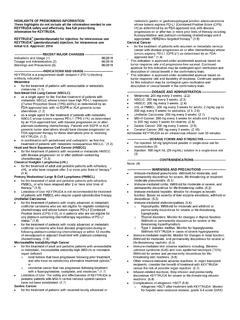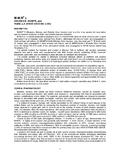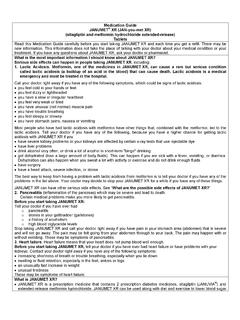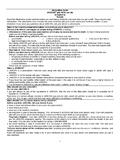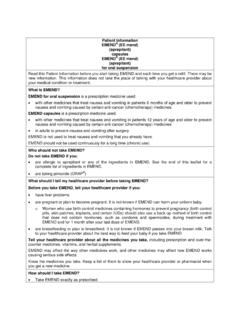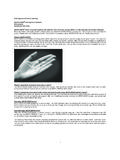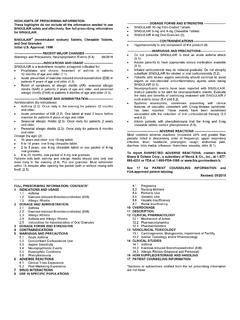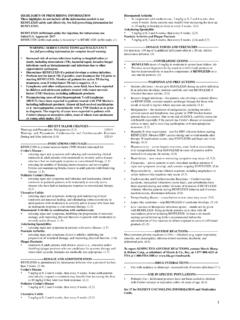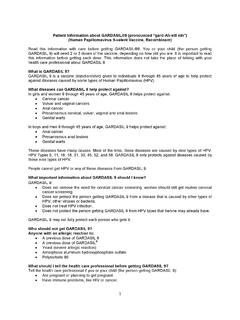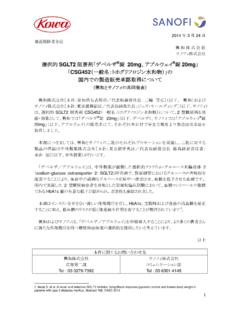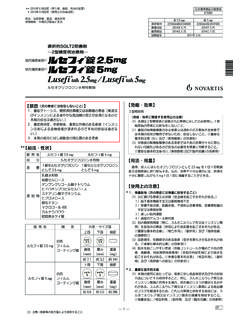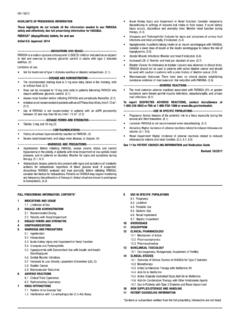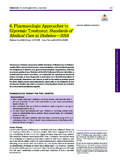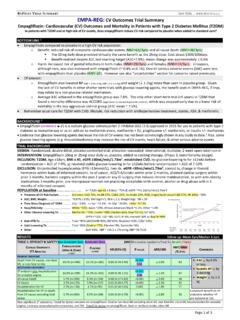Transcription of Ketoacidosis: Assess patients who present with signs …
1 HIGHLIGHTS OF PRESCRIBING INFORMATIONT hese highlights do not include all the information needed to use STEGLATRO safely and effectively. See full prescribing information for (ertugliflozin) tablets, for oral useInitial Approval: 2017---------------------------RECENT MAJOR CHANGES---------------------------Warnin gs and PrecautionsNecrotizingFasciitis of the Perineum( )10/2018----------------------------INDI CATIONS AND USAGE----------------------------STEGLAT ROis a sodium glucose co-transporter 2 (SGLT2) inhibitor indicated as an adjunct to diet and exercise to improve glycemic control in adults with type 2 diabetes mellitus.
2 (1)Limitations of Use: Not for the treatment of type 1 diabetes mellitus or diabeticketoacidosis. (1)-----------------------DOSAGE AND ADMINISTRATION----------------------- Recommended starting dose is 5 mg once daily, taken in the morning, with or without food. ( ) Increase dose to 15 mg once daily in those tolerating STEGLATRO and needing additional glycemic control. ( ) Assess renal function before initiating STEGLATRO and periodically thereafter ( ):oDo not use in patients with an estimated glomerular filtration rate (eGFR) below 30mL/ is not recommended in patients with an eGFR of 30 to less than 60 mL/ use is not recommended in patients with an eGFR persistently between 30 and less than 60mL/ ---------------------DOSAGE FORMS AND STRENGTHS---------------------Tablets: 5mg and 15mg (3)-------------------------------CONTRA INDICATIONS----------------------------- -- Severe renal impairment, end-stage renal disease, or dialysis.
3 (4, ) History of serious hypersensitivity reaction to STEGLATRO. (4)-----------------------WARNINGS AND PRECAUTIONS------------------------ Hypotension:May occur particularly in patients with renal impairment, the elderly, or patients on diuretics. Before initiating, Assess and correct volume status. Monitor for signs and symptoms during therapy. ( ) Ketoacidosis: Assess patients who present with signs and symptoms of metabolic acidosis for ketoacidosis, regardless of blood glucose level. If suspected, discontinue, evaluate, and treat promptly. Before initiating, consider risk factors for ketoacidosis. patients mayrequire monitoring and temporary discontinuation of therapy in clinical situations known to predispose to ketoacidosis.
4 ( ) Acute Kidney Injury and Impairment in Renal Function:Consider temporarily discontinuing in settings of reduced oral intake or fluid losses. If acute kidney injury occurs, discontinue and promptly treat. Monitor renal function. ( ) Urosepsis and Pyelonephritis:Evaluate patients for signs and symptoms of urinary tract infections and treat promptly, if indicated. ( ) Lower Limb Amputation:Before initiating, consider factors that may increase risk of amputation. Monitor patients for infections or ulcers of lower limbs, and discontinue if these occur. ( ) Hypoglycemia:Consider a lower dose of insulin or insulin secretagogue to reduce risk of hypoglycemia when used in combination.
5 ( ) Necrotizing Fasciitis of the Perineum(Fournier s gangrene): Serious, life-threatening cases have occurred in both females and males. Assess patients presenting with pain or tenderness, erythema, or swelling in the genital or perineal area, along with fever or malaise. If suspected, institute prompt treatment. ( ) Genital Mycotic Infections:Monitor and treat if indicated. ( ) Increased LDL-C:Monitorand treat as appropriate. ( ) ------------------------------ADVERSE REACTIONS------------------------------ The most common adverse reactions associated with STEGLATRO (incidence 5%) were female genital mycotic infections.
6 ( )To report SUSPECTED ADVERSE REACTIONS, contact Merck Sharp & Dohme Corp., a subsidiary of Merck & Co., Inc., at 1-877-888-4231 or FDA at 1-800-FDA-1088 or IN SPECIFIC POPULATIONS----------------------- Pregnancy:Advise females of the potential risk to a fetus especially during the second and third trimesters. ( ) Lactation:Breastfeeding not recommended. ( ) Geriatrics:Higher incidence of adverse reactions related to reduced intravascular volume. ( , ) Renal Impairment:Higher incidence of adverse reactions related to reduced intravascular volume and renal function. ( , , )See 17 for PATIENT COUNSELING INFORMATION and Medication : 10/2018 FULL PRESCRIBING INFORMATION.
7 CONTENTS*1 INDICATIONS AND USAGE2 DOSAGE AND with Renal Impairment3 DOSAGE FORMS AND STRENGTHS4 CONTRAINDICATIONS5 WARNINGS AND Kidney Injury and Impairment in Renal and Limb with Concomitant Use with Insulin and Insulin Fasciitis of the Mycotic Increases in Low-Density Lipoprotein Cholesterol (LDL-C) Macrovascular Outcomes6 ADVERSE Trials Experience7 DRUG Use with Insulin and Insulin Urine Glucose with 1,5-anhydroglucitol (1,5-AG) Assay8 USE IN SPECIFIC Impairment10 OVERDOSAGE11 DESCRIPTION12 CLINICAL of , Mutagenesis, Impairment of Fertility14 CLINICAL of Clinical Studies in patients with Type 2 Diabetes Study of Monotherapy Use of STEGLATRO in patients with Type 2 Diabetes Studies of Combination Therapy Use of STEGLATRO in patients with Type 2 Diabetes Study of STEGLATRO in patients with Moderate Renal Impairment and Type 2 Diabetes Mellitus16 HOW SUPPLIED/STORAGE AND HANDLING17 PATIENT COUNSELING INFORMATION*Sections or subsections omitted from the full prescribing information are not PRESCRIBING INFORMATION1 INDICATIONS AND USAGESTEGLATRO is indicated as an adjunct to diet and exercise to improve glycemic
8 Control in adults with type 2 diabetes of Use STEGLATRO is not recommended in patients with type 1 diabetes mellitus or for the treatment of diabetic AND Dosage The recommended starting dose of STEGLATRO is 5mg once daily, taken in the morning, with or without food. In patients tolerating STEGLATRO 5 mg once daily, the dose may be increased to a maximum recommended dose of 15 mg once daily if additional glycemic control is needed. In patients with volume depletion, correct this condition prior to initiation of STEGLATRO [see Warnings and Precautions ( )]. with Renal Impairment Assess renal function prior to initiation of STEGLATRO and periodicallythereafter [see Warnings and Precautions ( )].
9 Use of STEGLATRO is contraindicated in patients with an eGFR less than 30 mL/ [see Contraindications (4)]. Initiation of STEGLATRO is not recommended in patients with an eGFR of 30 mL/ m2to less than 60 mL/ [see Warnings and Precautions ( ) and Use in Specific Populations ( )]. Continued use of STEGLATRO is not recommended when eGFR is persistently between 30 and less than 60mL/ dose adjustment is needed in patients with mild renal FORMS AND STRENGTHS Tablets: 5 mg, pink, triangular-shaped debossed with 701 on one side and plain on the other side. Tablets: 15 mg, red, triangular-shaped debossed with 702 on one side and plain on the other Severe renal impairment, end-stage renal disease (ESRD), or dialysis [see Warnings and Precautions ( ) and Use in Specific Populations ( )].
10 History of a serious hypersensitivity reaction to AND causes intravascular volume contraction. Therefore, symptomatic hypotension may occur after initiating STEGLATRO [see Adverse Reactions ( )]particularly in patients with impaired renal function (eGFR less than 60 mL/ )[see Use in Specific Populations ( )], elderly patients ( 65 years), in patients with low systolic blood pressure, and in patients on diuretics. Before initiating STEGLATRO, volume status should be assessed and corrected if indicated. Monitor for signs and symptoms of hypotension after initiating of ketoacidosis, a serious life-threatening condition requiring urgent hospitalization, have been identified in clinical trials and postmarketing surveillance in patients with type 1 and type 2 diabetes mellitus receiving sodium glucose co-transporter-2 (SGLT2) inhibitors and cases have been reported in 3 STEGLATRO-treated patients in clinical trials.
